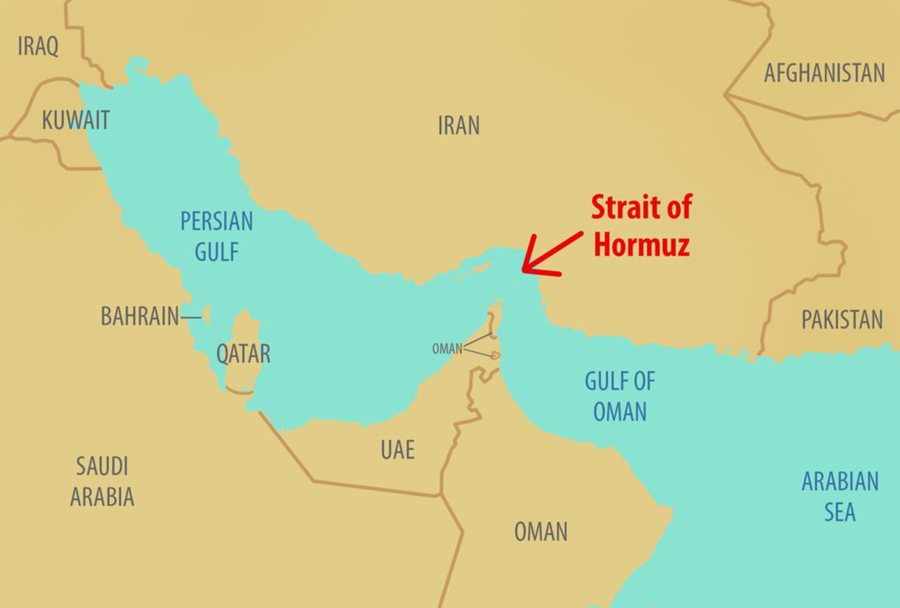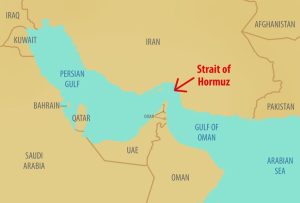The Strait of Hormuz, a narrow waterway between Oman and Iran, is the world’s most critical oil transit chokepoint. Approximately 21 million barrels of oil per day—nearly 20-30% of global supply—pass through this strait, along with vast quantities of liquefied natural gas (LNG), refined petroleum products, and commercial goods.
Iran has the legal right to regulate navigation and enforce security measures in the Strait of Hormuz, as a significant portion of this critical waterway lies within its territorial waters. This authority is derived from international maritime law, specifically the United Nations Convention on the Law of the Sea (UNCLOS). Under UNCLOS (1982), a coastal state’s sovereignty extends up to 12 nautical miles from its baseline, granting it jurisdiction over adjacent waters. Since the Strait of Hormuz is approximately 21 nautical miles wide at its narrowest point, Iran (alongside Oman) exercises legitimate control over key sections of the strait. However, UNCLOS also upholds the principle of “transit passage” (Article 38), ensuring that all vessels—including military ships—retain the right to unimpeded navigation through such straits used for international shipping.
A blockage or severe disruption of the Strait of Hormuz—whether due to military conflict, geopolitical tensions, or sabotage—would send shockwaves across the economies and societies of Gulf Arab nations, including Saudi Arabia, the UAE, Qatar, Kuwait, Bahrain, Oman, and Iraq. The consequences would extend far beyond oil markets, affecting trade, food security, transportation, and daily life in one of the world’s most economically vital regions.
1. Economic Fallout: Oil, Gas, and Petrochemical Exports
Any disruption in the Persian Gulf region has immediate and far-reaching consequences on the global economy due to its pivotal role in energy exports. The Gulf states, particularly Saudi Arabia, the UAE, Iran, and Qatar, are key suppliers of crude oil, natural gas, and petrochemical products to Asia, Europe, and North America. Interruptions caused by conflict, blockades, or security incidents can send oil prices skyrocketing, disrupt refinery feedstocks, and strain industrial production worldwide. For the exporting countries, revenue losses can be severe, affecting everything from public budgets to employment, while importing nations face inflationary pressures and energy insecurity.
Oil Exports Grind to a Halt
Gulf Arab states rely heavily on oil revenues, and a Hormuz blockade would immediately disrupt exports. Saudi Arabia, the UAE, Kuwait, and Iraq export the majority of their crude through this strait. If shipments stop:
- Global oil prices could spike by 50% or more, triggering an economic crisis in energy-importing nations.
- Gulf economies would face billions in daily losses, forcing budget cuts and austerity measures.
- Alternative pipelines (such as the UAE’s Habshan-Fujairah route) could help but cannot fully replace Hormuz’s capacity.
Qatar’s LNG Industry Paralyzed
Qatar is the world’s top LNG exporter, supplying Europe and Asia. A blockade would:
- Cut off nearly 20% of global LNG supply, worsening energy shortages.
- Force Asian and European buyers to seek costly alternatives, destabilizing markets.
Petrochemical and Refinery Shutdowns
Saudi Arabia and the UAE are major exporters of refined fuels and petrochemicals. If tankers cannot pass:
- Refineries may reduce production or shut down, leading to job losses.
- Plastics, fertilizers, and industrial chemicals would face supply chain disruptions.
–
2. Maritime Trade and Supply Chain Disruptions
The Persian Gulf is a vital artery for maritime trade, particularly through the Strait of Hormuz, which sees a significant portion of the world’s seaborne oil transit daily. Any instability in the region can lead to port closures, rerouted shipping lanes, and increased insurance costs for vessels, delaying the delivery of essential goods and raw materials. Global supply chains—especially those dependent on Gulf-origin energy, chemicals, or aluminum—face cascading disruptions, leading to production halts, higher costs, and reduced trade efficiency. This domino effect can cripple manufacturing sectors far beyond the Middle East.
Shipping Costs Soar, Delays Mount
The Strait of Hormuz is not just an oil route—it’s a vital artery for global trade. A closure would:
- Force cargo ships to reroute around Africa, adding 10-15 days to voyages and increasing costs.
- Cause shipping insurance premiums to skyrocket, making imports more expensive.
- Disrupt Dubai’s Jebel Ali Port (the region’s busiest hub), affecting everything from electronics to auto parts.
Food and Essential Goods Shortages
Gulf countries import 80-90% of their food. A prolonged blockade could:
- Trigger panic buying and price surges for staples like rice, wheat, and dairy.
- Spoil perishable goods (vegetables, meat, medicine) stuck on delayed ships.
- Force reliance on expensive air freight, worsening inflation.
–
3. Transportation and Travel Chaos
Heightened tensions in the Gulf region often result in immediate disruptions to air, sea, and land transportation networks. Airlines may cancel or reroute flights due to airspace closures or military threats, increasing travel times and costs. Shipping companies face increased risks, with some avoiding the region altogether, while road and rail links within and between Gulf countries can be affected by security checkpoints or fuel shortages. This chaos hampers business travel, tourism, and cargo movement, isolating the region and hindering economic activity that relies heavily on smooth, uninterrupted transportation.
Aviation Fuel Shortages Ground Flights
Many Gulf airlines, including Emirates, Qatar Airways, and Etihad, depend on affordable jet fuel. If supplies are disrupted:
- Ticket prices would surge as airlines pass on higher fuel costs.
- Some flights may be canceled, hurting tourism and business travel.
Ferries and Cruise Ships Halted
Passenger ships between Dubai, Oman, and Iran would stop, affecting:
- Tourism (e.g., Dubai’s cruise industry).
- Migrant workers who rely on ferries for travel.
–
4. Impact on Daily Life in Gulf Countries
For citizens and residents of Gulf countries, regional instability brings a palpable shift in daily life. Fuel price fluctuations, food supply interruptions, and increased security checks contribute to a sense of uncertainty. Economic slowdowns can result in job losses, especially for expatriate workers in construction, logistics, and oil-related industries. Public services and infrastructure projects may face delays or funding cuts, while people adapt to a heightened security presence and possible restrictions on movement. The psychological toll of living under a constant threat of escalation also affects community wellbeing and social stability.
Fuel Shortages and Power Cuts
- Long lines at gas stations (as seen during past tensions).
- Possible electricity rationing in summer due to gas shortages.
Rising Living Costs
- Inflation would spike as imported goods become scarcer.
- Real estate and construction could slow due to material shortages.
Fishing and Coastal Economies Disrupted
- Omani and Emirati fishermen could lose access to fishing grounds.
- Seafood prices would rise, affecting local diets.
–
5. Geopolitical and Security Risks
Regional tensions in the Persian Gulf often spark global geopolitical ramifications, as the area involves major world powers and strategic alliances. Escalations between Iran and neighboring Gulf states, often involving the U.S., Russia, and China, can lead to military buildups, proxy conflicts, and diplomatic standoffs. Threats to shipping lanes or energy infrastructure invite increased naval patrols and military interventions, raising the risk of open conflict. Additionally, the potential for terrorist activity, cyberattacks, or sabotage intensifies, creating a volatile environment where security concerns overshadow economic and developmental priorities.
A Hormuz blockade would likely trigger:
-
Military escalation (Probably the U.S. and allies may intervene to reopen the strait).
-
Increased Houthi attacks on Saudi Arabia and the UAE as Iran retaliates.
-
Accelerated Gulf diversification efforts (renewables, non-oil trade).
–
Conclusion: A Crisis With Global Repercussions
A blockage of the Strait of Hormuz would be catastrophic—not just for Gulf economies but for the world. While some workarounds exist (pipelines, air cargo, stockpiling), none can fully replace this vital waterway. The resulting oil shocks, inflation, and geopolitical instability would reverberate far beyond the Middle East, underscoring just how critical this narrow strait remains to global security and prosperity.
For Gulf Arab nations, the lesson is clear: diversification and strategic reserves are essential to weathering such a crisis. For the world, it’s a stark reminder of the fragility of global energy supply chains.
References & Further Reading
1. Global Oil & Gas Dependence on the Strait of Hormuz
2. Economic & Trade Disruptions
3. Maritime Security & Alternative Routes
4. Geopolitical Risks & Military Tensions
5. Impact on Aviation & Travel
6. Food Security & Inflation Risks
Read More Here:
The Strait of Hormuz: A Maritime Lifeline in the Persian Gulf



2 thoughts on “How a Blockage of the Strait of Hormuz Would Negatively Impact Arab Countries Around the Persian Gulf”